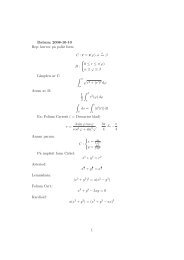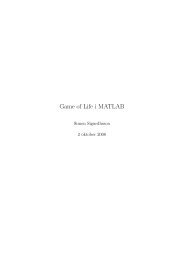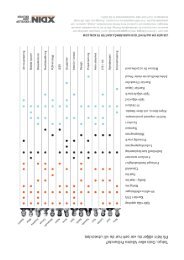Create successful ePaper yourself
Turn your PDF publications into a flip-book with our unique Google optimized e-Paper software.
<strong>Using</strong> <strong>Tratts</strong> <strong>To</strong> <strong>Create</strong> <strong>Big</strong> <strong>Numbers</strong><br />
danr Rosén, Stefan skangas<br />
In this paper we investigate the process of creating big numbers. A well-known example of a<br />
big number is Graham’s Number, but with the advanced insights of tratts developed in this<br />
article it is but a grain of sand in comparison.<br />
Acknowledgements<br />
We would like to thank Malin Ahlberg for her proof-reading and boundless support during<br />
this work. We would also like to say Hello World! to everyone in #ilovehugs: thanks for<br />
brightening up our lives.<br />
Background<br />
This paper begins with a recap of how to create the so called Graham’s Number. We start by<br />
defining the up arrow operator, ↑, as exponentiation:<br />
k ↑ n = k n<br />
This operator is iterated by defining ↑ m recursively:<br />
k ↑ 1 n = k ↑ n<br />
k ↑ m+1 n = k ↑ m k ↑ m ··· ↑ m k<br />
} {{ }<br />
ntimes<br />
Just as exponentiation, ↑ associates to the right, so for example 3 ↑ 2 3 is:<br />
3 ↑ 2 3 = 3 ↑ (3 ↑ 3)<br />
= 3 33<br />
= 3 27<br />
= 7625597484987<br />
We now define the unary operator g − as follows:<br />
g 1 = 3 ↑ 4 3<br />
g n+1 = 3 ↑ gn 3<br />
The famously big Graham’s number g 64 is defined by the recurrence above, but as we shall<br />
see this is in fact a very small number.<br />
Submitted to:<br />
Universal Rejection
2 <strong>Using</strong> <strong>Tratts</strong> <strong>To</strong> <strong>Create</strong> <strong>Big</strong> <strong>Numbers</strong><br />
Related work<br />
Famous complexity theorist and quantum physicist Scott Aaronson has given a good introduction<br />
on “Who can name the biggest number” 1 , but he appeals to incomputable functions as the Busy<br />
Beaver numbers.<br />
A somewhat successful attempt on creating a big number was done by Ronald Graham 2 ,<br />
defined above.<br />
Beyond Graham’s number<br />
We start off by defining the G operator as follows:<br />
k Gn = g g..gn<br />
} {{ }<br />
k times<br />
As with ↑ we also iterate the operator G:<br />
k G 1 n = k Gn<br />
k G m+1 n = k G m k G m ··· G m k<br />
} {{ }<br />
ntimes<br />
<strong>To</strong> quickly get beyond the meagreness of Graham’s number g 64 , we define g64 1 by the following<br />
recurrence:<br />
g 1 1 = 3G 4 3<br />
g 1 m+1 = 3G g1 m<br />
3<br />
While g64 1 is already vastly greater than Graham’s number, we would like to iterate this<br />
process, by giving the G operator an additional argument. Let our old G operator be G 1 in a<br />
new sequence of operators. The second is defined thusly:<br />
k G 2 n = g 1 g 1 .. g 1 n } {{ }<br />
k times<br />
And we define g − − in mutually with G − , and let the base cases be g 1 − and G as above.<br />
g i+1<br />
1 = 3G 4 i 3<br />
g i+1<br />
m<br />
= 3G gi m<br />
i 3<br />
k G i+1 n = g i g ị . g i n } {{ }<br />
k times<br />
1 http://www.scottaaronson.com/writings/bignumbers.html<br />
2 Scientific American, "Mathematical Games", November 1977
danr Rosén, Stefan skangas 3<br />
We can now create the number t 1 , where t stands for tratt (we will later see why), as follows:<br />
t 1 = g g 64<br />
g 64<br />
By the Tratt Extensionality Theorem, we now iterate this process:<br />
t n+1 = g tn<br />
t n<br />
Now we can understand why it is called tratt. Just take a look on t 3 and t 4 :<br />
t 3 = g<br />
g gg 64<br />
g 64<br />
g g 64<br />
g 64<br />
g gg 64<br />
g 64<br />
g g 64<br />
g 64<br />
t 4 = g<br />
g gg 64<br />
g 64<br />
g g 64<br />
g<br />
g 64<br />
g gg 64<br />
g 64<br />
g g 64<br />
g 64<br />
g gg 64<br />
g 64<br />
g g 64<br />
g<br />
g 64<br />
g gg 64<br />
g 64<br />
g g 64<br />
g 64<br />
Both look exactly like a tratt! Of course, a rather big number to remember is t g64 . But let<br />
us also define the tratt operator T i :<br />
We now have a series of vast numbers V i :<br />
k T 1 n = t t..tn<br />
} {{ }<br />
k times<br />
k T i+1 n = k T i k T i ··· T i k<br />
} {{ }<br />
ntimes<br />
Conclusions<br />
V 1 = 3T 4 3<br />
V i+1 = 3T V i<br />
3<br />
An example of a huge effectively computable number is V tg64 . We believe this is the biggest<br />
number ever imagined.<br />
Future work<br />
The reader is invited to construct tratts of V , to obtain even larger numbers.

















